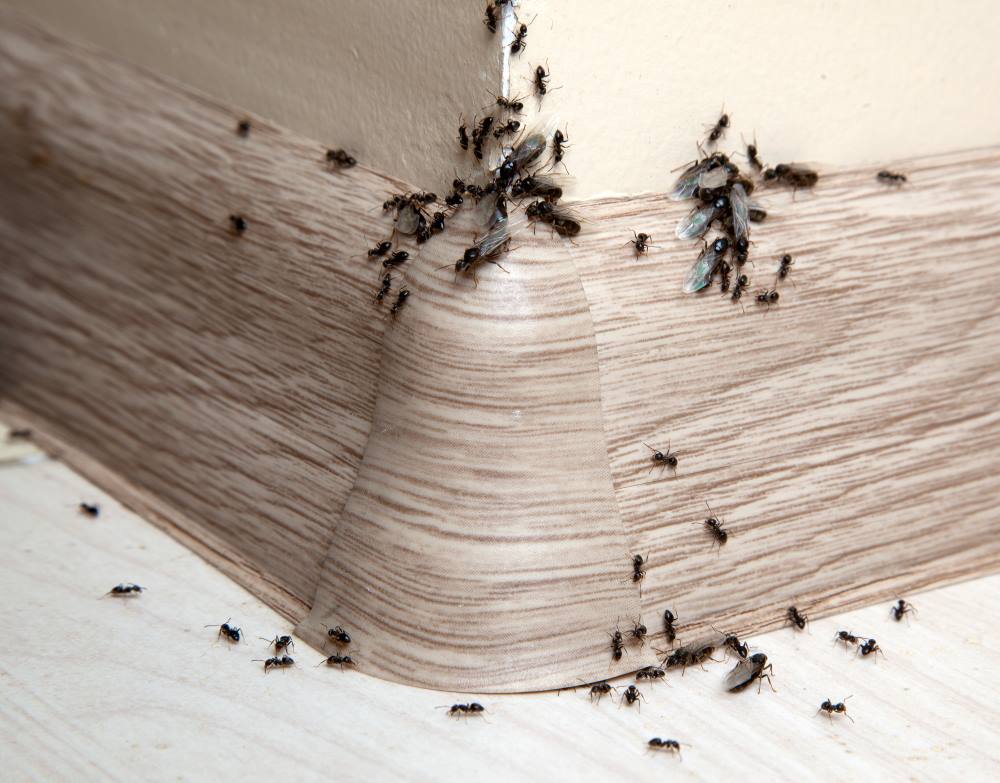
You’ve seen it before: the sudden appearance of ants marching single file along your countertops, floors, or window sills. It’s an unsettling sight, and you can’t help but wonder where they’re coming from. A closer look may reveal that the ants are actually making their way in and out of small openings in your walls. Just the thought of ants in walls is enough to send shivers down your spine, but rest assured, you’re not alone.
Ants are experts at finding their way into your home, and once they do, they’re not keen on leaving. The good news is that there are effective ways to get rid of ants in walls and prevent them from coming back. This article will delve into the world of ants, their secret invasion tactics, and how you can fight back to reclaim your home from these pesky intruders.
Understanding the ants’ secret invasion
Ants are social insects, living in colonies that can range from a few hundred to millions of individuals. They are masters of communication, using pheromones to relay messages to their fellow ants. When a scout ant stumbles upon a food source, it leaves a pheromone trail leading back to the colony. This trail attracts other ants, who then join the procession to and from the food source.
So, why are ants in walls such a common problem? The simple answer is that ants are resourceful and adaptable creatures. Walls provide a perfect environment for ants to build their nests, as they offer shelter from predators, protection from the elements, and easy access to food sources within your home. By nesting in your walls, ants can discreetly invade your home without you even realizing it.
Common types of ants found in walls
There are several species of ants that are known to invade homes and build their nests in walls. Some of the most common types include:
- Carpenter ants: These large, black ants are notorious for their wood-destroying habits. Carpenter ants don’t actually eat wood, but they do excavate it to create their nests. Over time, this can cause significant structural damage to your home.
- Odorous house ants: As their name suggests, these ants emit a foul odor when crushed. They are small, dark brown ants that are attracted to sweet substances and are commonly found in homes.
- Pharaoh ants: These tiny, pale yellow ants are notorious for being difficult to control. They prefer warm, humid environments and are often found in kitchens and bathrooms.
- Pavement ants: These small, dark brown ants are commonly found nesting under pavement, but they can also find their way into walls. They are attracted to greasy foods and are often found near kitchen areas.
The dangers of ants in walls
While ants in walls may seem like a minor annoyance, they can pose a threat to both your home and your health. Left unchecked, an ant infestation can lead to:
- Structural damage: As mentioned earlier, carpenter ants can cause significant damage to your home by excavating wood to create their nests. Over time, this can weaken the structural integrity of your home and may require costly repairs.
- Contaminated food: Ants are not picky eaters and will readily feed on whatever food they can find. This means that any food left out in your home could become contaminated with bacteria as ants crawl over it. Consuming contaminated food can lead to food poisoning or other illnesses.
- Allergies and asthma: Some people may be allergic to ant bites or the proteins in their exoskeletons. Exposure to ants can also trigger asthma symptoms in some individuals.
For information of repairing walls that have been damaged by carpenter ants, check out this article from SF Gate.
How to detect ants in walls
If you suspect you have ants in walls, there are a few signs to look out for:
- Visible trails: One of the most obvious signs of ants in walls is the presence of ant trails. These trails are formed as ants follow pheromone trails left by scout ants. Keep an eye out for ants marching in a line along your walls, baseboards, or window sills.
- Frass: Frass is a mixture of wood shavings and ant feces that is often found near carpenter ant nests. If you notice small piles of frass along your walls or baseboards, it could be a sign that carpenter ants are nesting in your walls.
- Sounds: Ants in walls can sometimes be heard as they move around and excavate wood to create their nests. Listen for faint rustling or tapping sounds coming from your walls, particularly at night when ants are most active.
Preventative measures to keep ants at bay
Preventing ants from invading your walls in the first place is always the best course of action. Here are some preventative measures you can take:
- Seal entry points: Inspect the exterior of your home for small cracks or gaps where ants could be entering. Seal these openings with caulk or another appropriate material to keep ants out.
- Eliminate food sources: Ants are attracted to food, so it’s important to keep your kitchen clean and store food in airtight containers. Wipe up spills and crumbs immediately, and avoid leaving dirty dishes in the sink overnight.
- Trim vegetation: Keep tree branches, shrubs, and other vegetation trimmed back from your house. Ants can use these as a bridge to enter your home.
- Eliminate excess moisture: Many ants, including carpenter ants, are attracted to moist environments. Fix any leaks in your home and use a dehumidifier if necessary to reduce humidity levels.
Natural ways to get rid of ants in walls
If you already have ants in walls, there are several natural remedies you can try:
- Diatomaceous earth: This natural powder is made from the fossilized remains of diatoms, a type of algae. When ants come into contact with diatomaceous earth, it damages their exoskeletons, causing them to dehydrate and die. Sprinkle diatomaceous earth along the ant trails and near any openings where ants are entering your walls.
- Boric acid: Mix boric acid with sugar or another sweet substance to create a bait that ants will be attracted to. The ants will take the bait back to their nest, where it will be shared with other ants and eventually kill the entire colony. Be sure to keep boric acid out of reach of children and pets.
- Essential oils: Some essential oils, such as peppermint, tea tree, and lemon, can be effective in repelling ants. Mix a few drops of essential oil with water and spray it along ant trails and any openings where ants are entering your walls.
Chemical solutions for eliminating ants in walls
If natural remedies aren’t working, you may need to resort to chemical solutions to get rid of ants in walls:
- Ant baits: Ant baits are a popular and effective way to eliminate ants in walls. These baits contain a slow-acting insecticide that ants will take back to their nest, where it will be shared with other ants and eventually kill the entire colony. Be sure to follow the instructions on the bait packaging and keep it out of reach of children and pets.
- Insecticide sprays: There are several insecticide sprays on the market designed to kill ants on contact. While these sprays can be effective in killing ants, they may not reach the entire colony nesting in your walls. Be sure to follow the instructions on the spray packaging and use caution when applying it near food or areas where children and pets may be present.
When to call a professional exterminator
If you’ve tried the above methods and are still struggling with ants in walls, it may be time to call in a professional exterminator. A professional will have the knowledge, experience, and tools to effectively eliminate the ant infestation and help prevent future invasions.
Consider calling a professional exterminator if:
- The ant infestation is severe or widespread throughout your home.
- The ants are causing significant damage to your home’s structure.
- You’ve tried multiple methods to get rid of the ants with no success.
Conclusion and final tips for managing ants in walls
Ants in walls can be a frustrating and persistent problem, but with the right approach, you can effectively eliminate these pesky intruders and prevent them from returning. By understanding the ants’ secret invasion tactics, taking preventative measures, and using a combination of natural and chemical solutions, you can reclaim your home from these unwelcome guests.
Remember to be patient and persistent in your efforts to rid your home of ants. It may take some time to fully eliminate the infestation, particularly if it has been established for a while. Keep an eye out for signs of ants inwalls, and take action as soon as possible to prevent the problem from getting worse.
Here are a few final tips to help you manage ants in walls:
- Regularly clean and inspect your home: Regular cleaning and inspections can help you spot ant infestations early on and take action before they become a major problem.
- Use a combination of methods: Using a combination of preventative measures, natural remedies, and chemical solutions can be the most effective way to eliminate ants in walls.
- Stay vigilant: Even after you’ve eliminated the ant infestation, it’s important to stay vigilant and take steps to prevent it from happening again. Keep your home clean, seal any openings, and eliminate food and water sources to keep ants at bay.
In conclusion, ants in walls can be a frustrating and persistent problem, but with the right approach, you can effectively eliminate them and prevent them from coming back. By understanding the ants’ secret invasion tactics, taking preventative measures, and using a combination of natural and chemical solutions, you can reclaim your home from these unwelcome guests. If you need help getting rid of ants in walls, don’t hesitate to contact a professional exterminator like Banner Pest Services.


